Physical Address
304 North Cardinal St.
Dorchester Center, MA 02124
The anatomy and function of the brain is fascinating and complex, and we are still only scratching the surface in terms of our understanding of these structures. Nevertheless, a basic understanding of structure and function is critical in providing meaningful and accurate reporting of the pathology in the brain. Although we will discuss the development of the brain in Chapter 8 , we will address the pertinent aspects of normal adult anatomy as it pertains to imaging interpretation in this chapter. Ready? Set? Here we go!
There are four lobes in each cerebral hemisphere: the frontal, parietal, occipital, and temporal lobes. The frontal lobe is separated from the parietal lobe by the central (Rolandic) sulcus, the parietal lobe is separated from the occipital lobe by the parietooccipital sulcus, and the temporal lobe is separated from the frontal and parietal lobes by the sylvian (lateral) fissure ( Fig. 1-1 ).
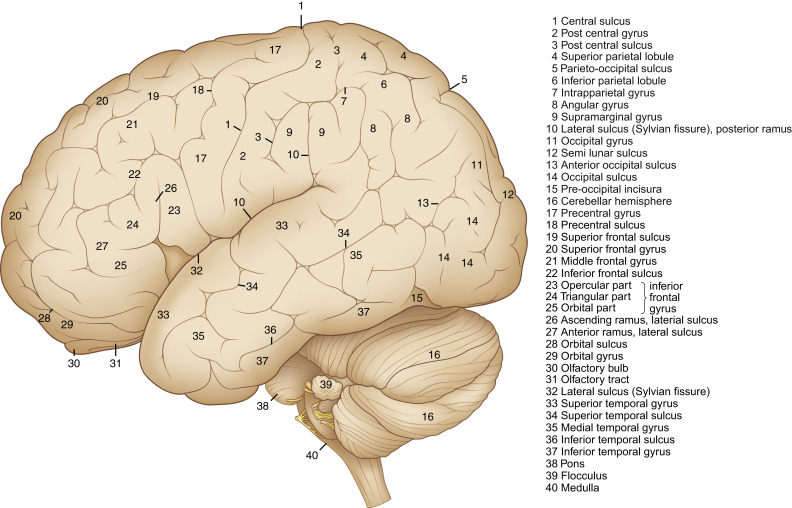
The main named areas of the frontal lobe are the precentral gyrus (the primary motor strip of the cerebral cortex) and the three frontal gyri anterior to the motor strip: the superior, middle, and inferior frontal gyri. In front of the motor cortex is, quite naturally, the premotor cortex (Brodmann area 6). The dorsolateral prefrontal cortex (DLPFC or DL-PFC) is a critical area frequently referred to by the functional magnetic resonance imaging (fMRI) gurus who ascribe a great deal of cognition/memory/planning to it. It lies in the middle frontal gyrus of humans. It includes Brodmann area 9 and 46 and lies anterolateral to the premotor cortex. The frontal operculum (superior to the sylvian fissure and in the frontal lobe) contains portions of the Broca motor speech area. On the medial surface of the frontal lobe is the cingulate gyrus just superior to and bounding the corpus callosum, and the gyrus rectus extending along the medial basal surface of the anterior cranial fossa ( Figs. 1-1, 1-2 ).
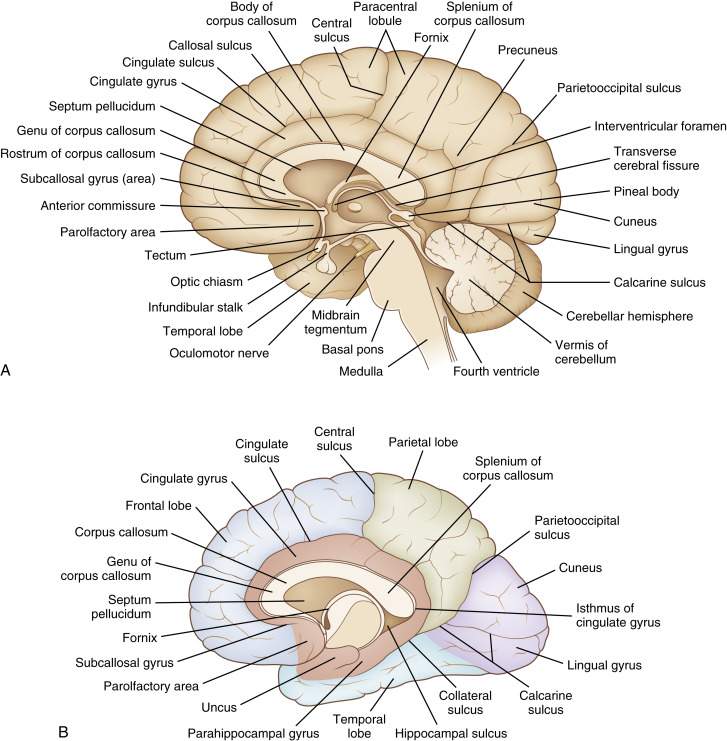
The parietal lobe contains the postcentral gyrus (the center for somatic sensation), the supramarginal gyrus just above the temporal lobe, and the angular gyrus near the apex of the temporal lobe. Two superficial gyri of note are the superior and inferior parietal lobules, which are separated by an interparietal sulcus. On its medial side the precuneate gyrus is present in front of the parietooccipital fissure, with the cuneate gyrus posteriorly in the occipital lobe (see Fig. 1-2 ).
The temporal lobe contains the brain-functioning elements of speech, memory, emotion and hearing. Superior (auditory), medial, and inferior temporal gyri are seen on the superficial aspect of the brain (see Fig. 1-1 ). The posterior portion of the superior temporal gyrus subserves language comprehension, the so-called Wernicke area. Deep to the sylvian fissure is the insula, or isle of Reil, which is bounded laterally by the opercular regions and subserves taste function. The inferior part of the insula near the sylvian fissure is called the limen of the insula. The inferior and medial surface of the temporal lobe reveals the parahippocampal gyrus with the hippocampus just superior to it ( Fig. 1-3 ). Anteriorly, the almond-shaped amygdala dominates. In the coronal plane, starting at the right collateral sulcus just inferior to the parahippocampus and traveling northward, you would first hit the entorhinal cortex, then turn at the parasubiculum, pass along the subiculum proper, and continue laterally to the presubiculum. All of these represent parahippocampal structures. You would then curl in a spiral into the hippocampus’ cornu ammonis and dentate gyrus with the fimbria found superomedially and the alveus on top of the cornu ammonis. Are you dizzy yet? The lateral-most portion of the cornu is particularly sensitive to anoxic injury and is the site where mesial temporal sclerosis occurs.
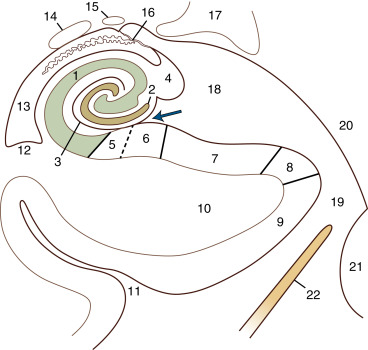
The occipital lobe is the lobe most commonly associated with visual function. At its apex is the calcarine sulcus, with the cuneate gyrus just above it (posteroinferior to the parietooccipital fissure) and the calcarine gyrus just below it (see Fig. 1-2 ).
The diencephalon contains the thalamus and hypothalamus. The thalamus has many nuclei, the most important of which (according to your ears and eyes) are the medial and lateral geniculate nuclei associated with auditory and visual functions, respectively. The thalamus is found on either side of the third ventricle and connects across the midline by the massa intermedia. Its other functions include motor relays, limbic outputs, and coordination of movement. Portions of the thalamus also subserve pain, cognition and emotions. The hypothalamus is located at the floor of the third ventricle, above the optic chiasm and suprasellar cistern. The hypothalamus is connected to the posterior pituitary via the infundibulum, or stalk, through which hormonal information to the pituitary gland is transmitted. The hypothalamus is critical to the autonomic functions of the body. Is it getting hot in here?
Starting superiorly, the brain stem consists of the midbrain, pons, and medulla.
The mesencephalon differentiates into the midbrain. The midbrain is the site of origin of the third and fourth cranial nerves. Additionally, the midbrain contains the red nucleus, substantia nigra, and cerebral aqueduct, or aqueduct of Sylvius ( Fig. 1-4 ). White matter tracts conducting the motor and sensory commands pass through the midbrain. The midbrain is also separated into the tegmentum and tectum, which refer to portions of the midbrain anterior and posterior to the cerebral aqueduct, respectively. The tectum, or roof, consists of the quadrigeminal plate (corpora quadrigemina), which houses the superior and inferior colliculi. The tegmentum contains the fiber tracts, red nuclei, third and fourth cranial nerve nuclei, and periaqueductal gray matter. The substantia nigra is within the anterior border of the tegmentum. Anterior to the tegmentum are the cerebral peduncles, which have somewhat of a “Mickey Mouse ears” configuration. Remember, just as there is only one Mickey, there is only one pair of cerebral peduncles.
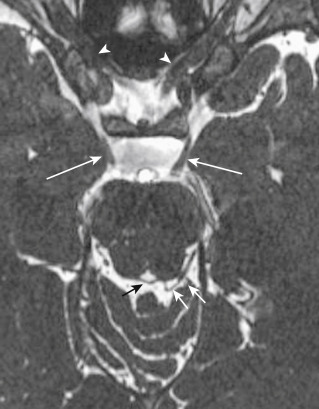
The metencephalon develops into the pons and cerebellum. The pons contains the nuclei for cranial nerves V, VI, VII, and VIII ( Figs. 1-5, 1-6 ). Pontine white matter tracts transmit sensory and motor fibers to the face and body. The pons also houses major connections of the reticular activating system for vital functions. One identifies the pons on the sagittal scan by its “pregnant belly.”
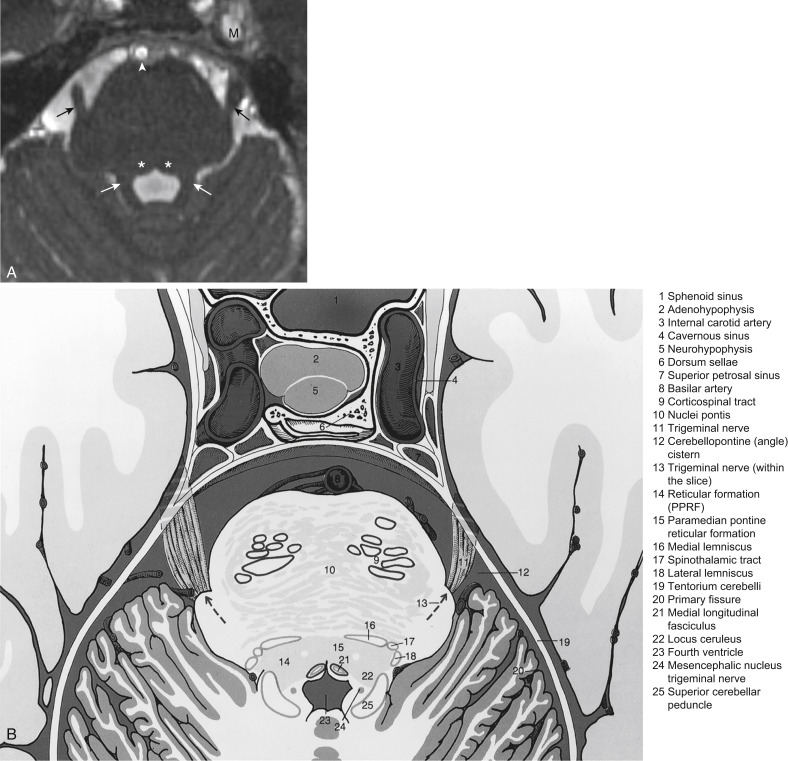
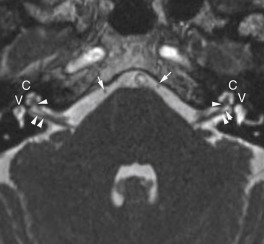
The myelencephalon becomes the medulla. The medulla contains the nuclei for cranial nerves IX, X, XI, and XII. Again, the sensory and motor tracts to and from the face and brain are transmitted through the medulla. Other named portions of the medulla include the pyramids, an anterior paramedian collection of fibers transmitting motor function, and the olivary nucleus in the mid-medulla ( Fig. 1-7 ).
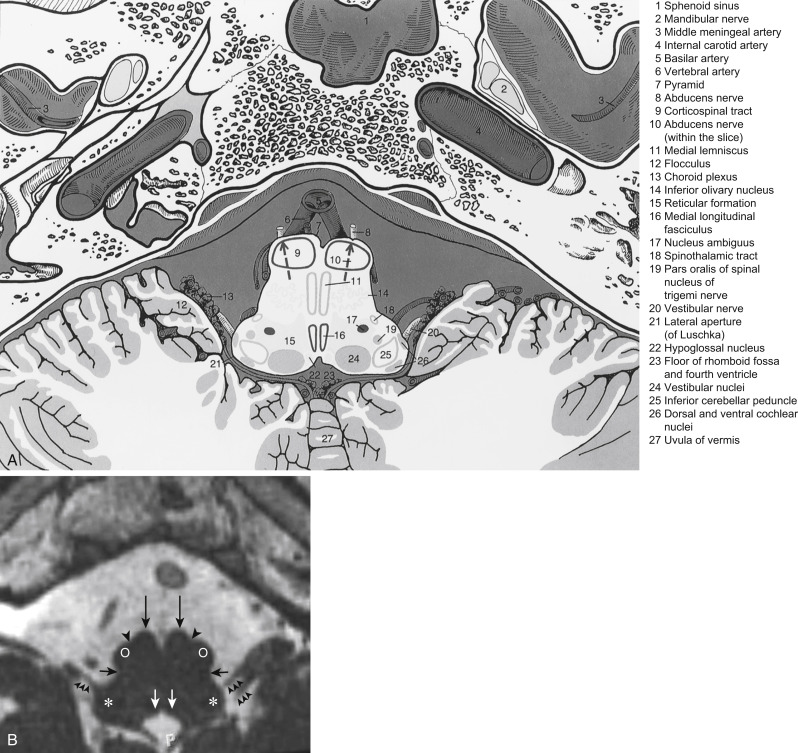
The cerebellum is located in the infratentorial compartment posterior to the brain stem. The anatomy of the cerebellum is complex, with many named areas. For simplicity’s sake, most people separate the cerebellum into the superior and inferior vermis and reserve the term cerebellar hemispheres for the rest of the lateral and central portions of the cerebellum.
For those interested in details, the superior vermis has a central lobule and lingula visible anteriorly, and the inferior vermis has a nodulus, uvula, pyramid, and tuber on its inferior surface ( Fig. 1-8 ). The superior surface provides a view of the culmen, declive, and folium of the superior vermis. Superolaterally, there is a bump called the flocculus, which may extend toward the cerebellopontine angle cistern. This is a potential “pseudotumor,” often misidentified as a vestibular schwannoma. The tonsils are located inferolaterally and are the structures that herniate downward through the foramen magnum in Chiari malformations.
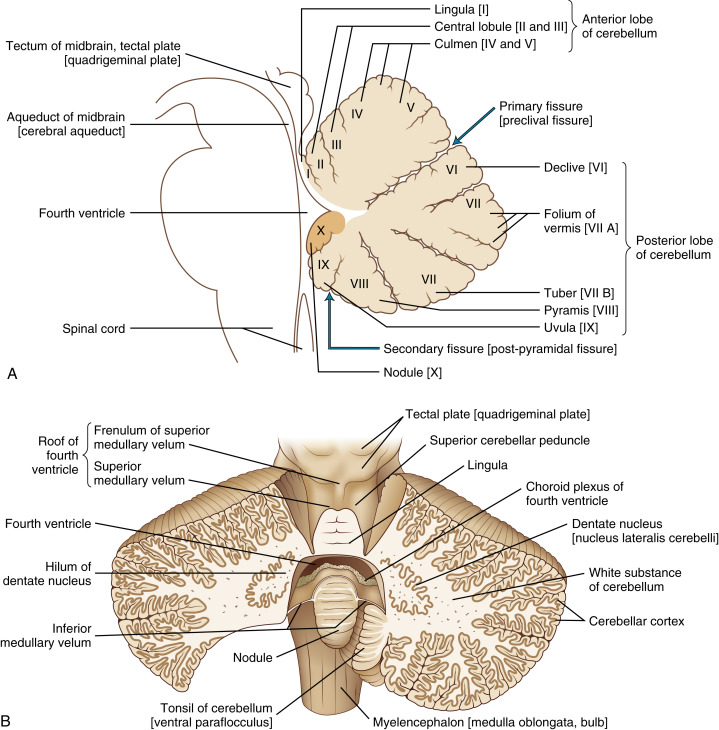
Gray matter masses in the cerebellum include the fastigial, globose, emboliform, and dentate nuclei; the dentate nuclei are seen well on T1-weighted images (T1WI), whereas the fastigial, globose, and emboliform nuclei cannot be discerned. The dentate nuclei are situated laterally in the white matter of the cerebellum, and can be seen on computed tomography (CT) because they may calcify in later life.
Three major white matter tracts connect the cerebellum to the brain stem bilaterally ( Fig. 1-9 ). The superior cerebellar peduncle (brachium conjunctivum) connects midbrain structures to the cerebellum, the middle cerebellar peduncle (brachium pontis) connects the pons to the cerebellum, and the inferior cerebellar peduncle (restiform body) connects the medulla to the cerebellum.
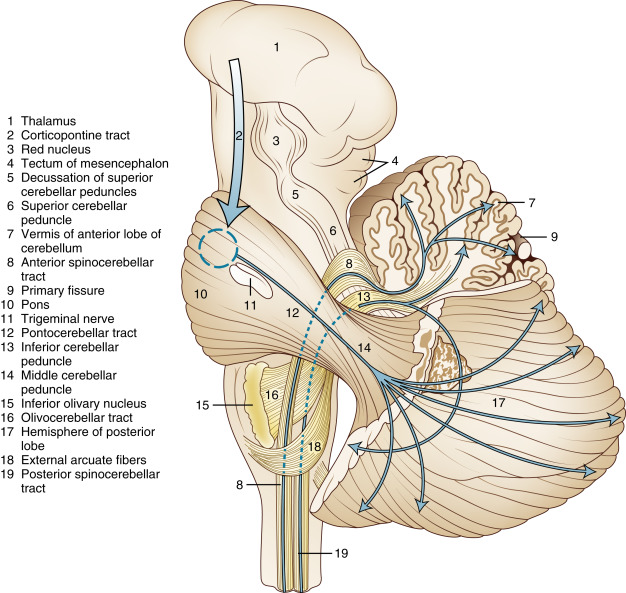
The flocculonodular lobe, fastigial nucleus, and uvula of the inferior vermis receive input from vestibular nerves and are thought to be involved primarily with maintaining equilibrium. Lesions of this part of the cerebellum, the archicerebellum, cause wide-based gait and dysequilibrium.
The superior vermis, most of the inferior vermis, and globose and emboliform nuclei receive spinocerebellar sensory information. Muscle tone information, postural tone, and coordination of locomotion appear to be influenced by these sites and by their effect on brain stem fibers, the red nuclei, and vestibular nuclei. The hemispheric portions of the cerebellum receive information from the pons and help to control coordination of voluntary movements. Abnormalities within the cerebellar hemispheres result in dysmetria, dysdiadochokinesis (say THAT five times fast!), intention tremors, nystagmus, and ataxia.
The corpus callosum is the large midline white matter tract that spans the two cerebral hemispheres. Its named parts include the rostrum (its tapered anteroinferior portion just above the anterior commissure), the genu (the anterior sweep), the body or trunk (the superiormost aspect), and the splenium (the posteriormost aspect; see Fig. 1-2 ). Often there may be focal narrowing within the posterior body, the so called “isthmus,” which is a normal anatomic variation and should not be confused with focal pathology.
Other white matter tracts that must tread carefully as they cross the midline include the anterior commissure, located at the inferior aspect of the corpus callosum just above the lamina terminalis, and the posterior commissure, just anterior to the pineal gland near the habenula. The anterior commissure transmits tracts from the amygdala and temporal lobe to the contralateral side. The habenula and hippocampal commissures cross-connect the two hemispheres and thalami.
The basal ganglia are known by a number of names in the neuroanatomic literature. These gray matter structures lie between the insula and midline. The globus pallidus is the medial gray matter structure identified just lateral to the genu of the internal capsule ( Fig. 1-10 ). Lateral to it lies the putamen. The caudate nucleus head indents the frontal horns of the lateral ventricle and is anterior to the globus pallidus; however, the body of the caudate courses over the globus pallidus, paralleling the lateral ventricle and ending in a tail of tissue near the amygdala.
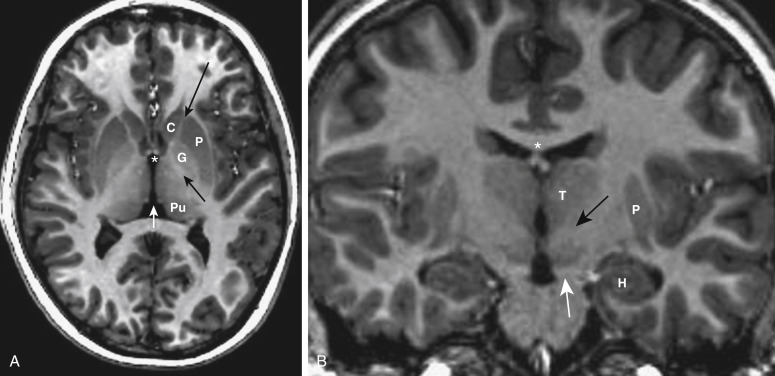
Additional terms used referring to the various portions of the basal ganglia include the striatum (caudate and putamen) and the lentiform or lenticular nuclei (the globus pallidus and putamen).
The basal ganglia receive fibers from the sensorimotor cortex, thalamus, and substantia nigra, as well as from each other. Efferents go to the same locations and to the hypothalamus. The main function of the basal ganglia appears to be coordination of smooth movement.
The other deep gray matter structures of interest in the supratentorial space are the thalami, which sit on either side of the third ventricle. The thalamus is subdivided into many different nuclei by white matter striae. The medial and lateral geniculate nuclei, located along the posterior aspect of the thalamus, serve as relay stations for visual and auditory function. The pulvinar is the posterior expansion of the thalamus. Behind the pulvinar are the wings of the ambient cistern. The massa intermedia connects the thalami across the third ventricle.
In the infratentorial space, the dentate nucleus, the largest deep gray matter structure, has connections to the red nuclei and to the thalami.
The normal volume of cerebrospinal fluid (CSF) in the entire central nervous system (CNS) is approximately 150 mL, with 75 mL distributed around the spinal cord, 25 mL within the ventricular system, and 50 mL surrounding the cortical sulci and in the cisterns at the base of the brain. In elderly persons, the intracranial CSF volume increases from 75 mL to a mean of approximately 150 mL in women and 190 mL in men. The normal production of CSF has been estimated to be approximately 450 mL/day, thereby replenishing the amount of CSF two to three times a day. Each ventricle’s choroid plexus contributes to CSF production, whereas the reabsorption of CSF occurs at the level of the arachnoid villi into the intravascular system from the extracellular fluid.
The flow of CSF runs from the lateral ventricles via the foramina of Monro, to the third ventricle, out the cerebral aqueduct of Sylvius, and into the fourth ventricle, finally exiting through foramina of Luschka (bilaterally) and Magendie (in the midline; Fig. 1-11 ). CSF then flows into the cisterns of the brain and the cervical subarachnoid space and then down the intrathecal spinal compartments. The CSF ultimately percolates back up over the convexities of the hemispheres, where it is resorbed by the arachnoid villi into the intravascular space.
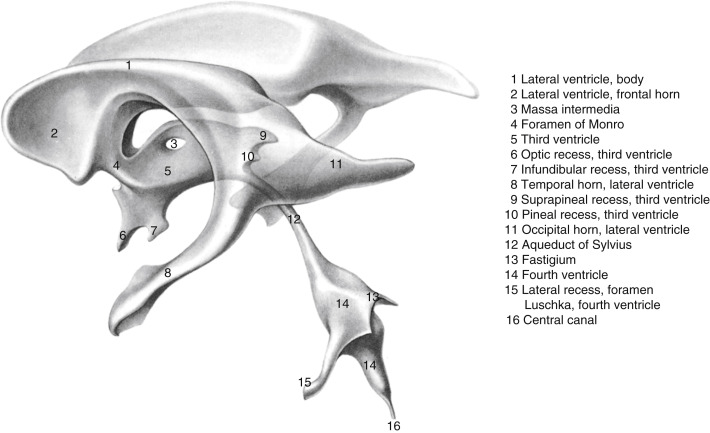
There are several named cisterns around the brain stem and midline structures ( Fig. 1-12 ). Contents of these spaces can be compromised depending on the pathology at play, and critical structures coursing through these spaces may be affected and be the source of the patient’s presenting complaint. Therefore, awareness of these cisterns and contents is critical in descriptions of different herniation syndromes and other pathologies that can be identified on imaging ( Table 1-1 ).
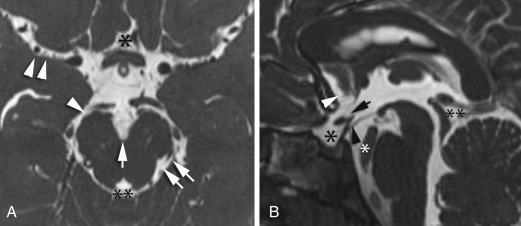
| Name | Location | Structures Traversing Cistern |
|---|---|---|
| Cisterna magna | Posteroinferior to fourth ventricle | None important |
| Circum-medullary cistern | Around medulla | Posterior inferior cerebellar artery |
| Superior cerebellar cistern | Above cerebellum | Basal vein of Rosenthal, vein of Galen |
| Prepontine cistern | Anterior to pons | Basilar artery, cranial nerves V and VI |
| Cerebellopontine angle cistern | Between pons and porus acusticus | Anterior inferior cerebellar artery, cranial nerves VII and VIII |
| Interpeduncular cistern | Between cerebral peduncles | Cranial nerve III |
| Ambient (crural) cistern | Around midbrain | Cranial nerve IV |
| Quadrigeminal plate cistern | Behind midbrain | None important |
| Suprasellar cistern | Above pituitary | Optic chiasm, cranial nerves III, IV, carotid arteries, pituitary stalk |
| Retropulvinar cistern (wings of ambient cistern) | Behind thalamus | Posterolateral choroidal artery |
| Cistern of lamina terminalis | Anterior to lamina terminalis, anterior commissure | ACA |
| Cistern of velum interpositum | Above 3rd ventricle | Internal cerebral vein, vein of Galen |
| Cistern of the ACA | Above corpus callosum | ACA |
The brain is covered in three protective layers of tissue, the meninges (or mater), which consist of pia, arachnoid, and dura. The dura (or pachymeninges) consists of the thickest and toughest layer and is adherent to the inner table of the skull extending to sutural margins. Pathologic conditions may occur in the space between the inner table and the dura, in the so-called epidural space, and result in mass effect on the underlying brain parenchyma. Epidural compartments are separated by sutures and pathologies typically do not cross the sutures when confined to the epidural space. Deep to the dura but superficial to the arachnoid mater is another potential space called the subdural space. When space-occupying pathologies are present here, cortical vessels that normally traverse the subarachnoid space just deep to the dura become compressed towards the surface of the brain, and the underlying brain parenchyma can also be compressed. Subarachnoid disease processes occur at the surface of the brain, deep to the arachnoid layer but superficial to the pia, and therefore assume a curvilinear configuration, extending along the surface of the sulci and gyri. Subpial processes do occur, however, the pia and arachnoid cannot always be readily distinguished on imaging; the pia and arachnoid layers are collectively referred to as the leptomeninges.
The pineal gland calcifies with age. A small percentage (2% of children less than 8 years old and 10% of adolescents) of children show calcification of the pineal gland. By 30 years of age, most people have calcified pineal glands. Anterior to the pineal gland, one often sees the habenular commissure as a calcified curvilinear structure.
The choroid plexus is calcified in about 5% of children by age 15, and most adults by age 40. Such calcifications may be seen in the lateral, third and fourth ventricles, as well as the foramina of Luschka, Magendie, and choroid fissures.
The dura of the falx and/or tentorium is virtually never calcified in children and should be viewed as suspicious for basal cell nevus syndrome in that setting. However, in adults, foci of calcification and even ossification of the dura and falx are not uncommon. The dura shows higher rates of calcification in patients who have had shunts placed or have been irradiated.
Basal ganglia calcification is also rarely observed in individuals less than 30 years of age and should provoke a search for metabolic disorders or a past history of perinatal infections if seen in youngsters. (See the online Appendix at ExpertConsult.com for causes of basal ganglia calcification.) Over the age of 30, however, basal ganglia calcifications are very common to the point that these do not necessarily need to be mentioned in routine reporting unless true pathology is suspected. Such benign basal ganglia mineralization is typically bilateral, although in some cases it may be more conspicuous on one side compared with the other. Care must be made not to confuse these physiologic calcifications, which are hyperdense on CT, with hemorrhage, which is also hyperdense on CT.
Understanding the functional anatomy requires a little bit of the cartographer in each of us (or a GPS-enabled smartphone). After having assimilated the destinations and points of departure, one should talk about the entire routes of neuronal travel. For functional anatomy, we can now use fMRI to identify the sites of cortical activation (the points of departure and destinations; Fig. 1-13 ) and diffusion tensor imaging to perform white matter tracking as the highways between gray matter destinations ( Fig. 1-14 ). The directionality of these white matter tracts can also be inferred now.
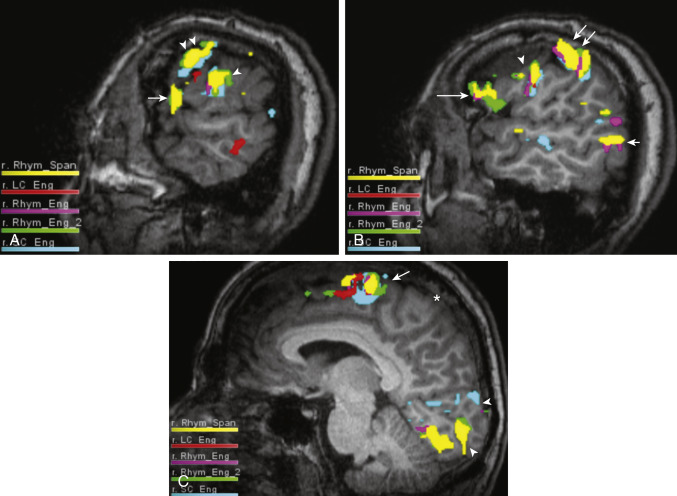
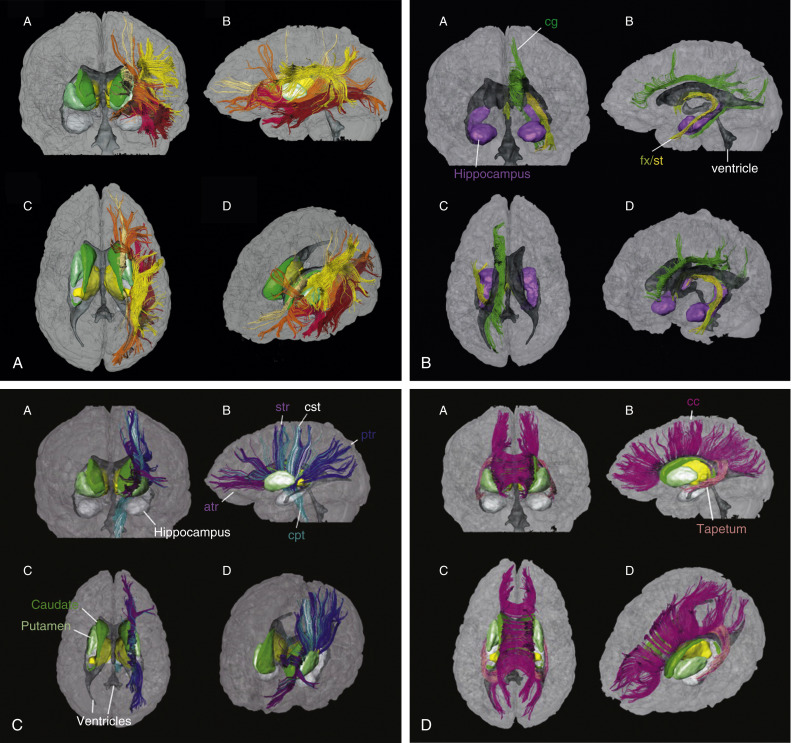
The functional units of the cerebral hemispheres have been separated into what are called Brodmann areas, and include areas 1 through 47. These numbered areas correspond to different gyri that subserve various functions. The Brodmann areas are the currency with which fMRI scientists transact business and are therefore important to be aware of. In addition, knowing which gyri are responsible for which properties can be critical to identifying lesions and predicting deficits in patients with strokes.
For example, Brodmann area 1 (aka S1) subserves primary somatosensory and position sense, and sits within the postcentral gyrus, in the paracentral lobule of the parietal lobe. Brodmann areas 2 and 3 subserve similar functions and are slightly posterior (2) and slightly anterior (3) to Brodmann area 1. Brodmann area 4 (M1) subserves primary motor function and resides within the precentral gyrus of the frontal lobe. Wernicke areas are comprised of Brodmann areas 21 and 22 (middle and superior temporal gyri respectively), and serve functions of higher order audition and speech reception respectively (can you hear me now?). Also within the superior temporal gyrus are areas 41 and 42 (aka A1-Wernicke and A2-Wernicke), which subserve functions of primary audition and auditory association/speech recognition respectively. Broca areas (Brodmann 44 and 45) located within the inferior frontal gyrus laterally subserve functions of speech expression and motor speech/tongue movement respectively.
The primary origin of the stimulus for motor function is the precentral gyrus of the frontal lobe, which receives input from many sensory areas ( Fig. 1-15 ; Table 1-2 ). Stimulation of the motor area of one precentral gyrus causes contraction of muscles on the opposite side of the body. The motor cortex, like the sensory area, is arranged such that the lower extremity is located superomedially along the paracentral lobule in the midline, whereas the upper extremity is located inferolaterally. The cells innervating the hip are at the top of the precentral sulcus; the leg is draped over medially along the interhemispheric fissure. The face (especially the tongue and mouth) has an inordinately large area of motor and sensory representation along the inferiormost aspect of the precentral motor strip on the surface of the brain, just above the sylvian fissure. The motor contribution to speech is located at the inferior frontal gyrus (frontal operculum regions).
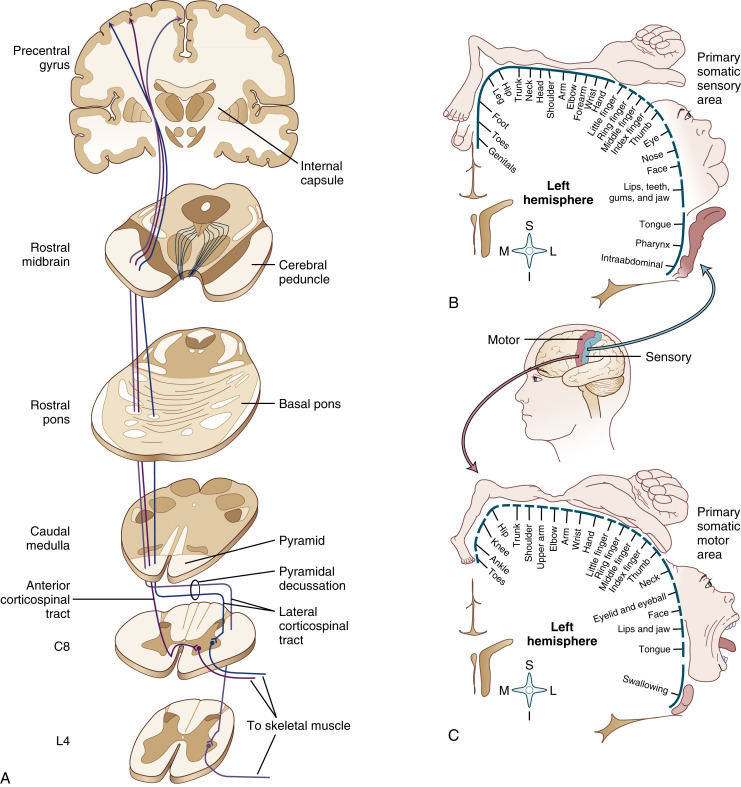
| Pathway | Course | Function |
|---|---|---|
| Lateral corticospinal tract | Primary motor cortex to corona radiata to posterior limb of internal capsule to cerebral peduncle to central pontine region to medulla through pyramidal decussation to posterolateral white matter of cord | Motor to contralateral extremities |
| Anterior corticospinal tract | Primary motor cortex to corona radiata to posterior limb of internal capsule to cerebral peduncle to central pontine region to medulla to anterior funiculus and anterior column of spinal cord | Motor to ipsilateral muscles |
| Rubrospinal tract | Red nucleus to decussation in ventral tegmentum of the midbrain through the lateral funiculus of the spinal cord to the posterolateral white matter of cord (with lateral corticospinal tract) | Motor control of contralateral limbs |
| Reticulospinal tract | Pons and medulla to ipsilateral anterior column of cord | Automatic movement of axial and limb muscles (walking, stretching, orienting behaviors) |
| Vestibulospinal tract | Vestibular nuclei to ipsilateral anterior columns in cord | Balance, postural adjustments, and head and neck coordination |
Sometimes finding the central sulcus on imaging can be difficult ( Fig. 1-16 ). This is necessary for discriminating motor from sensory areas particularly when surgery to resect a peri-Rolandic tumor is contemplated. Retaining motor function is desired. Consult Box 1-1 for some clues to identifying the central sulcus.
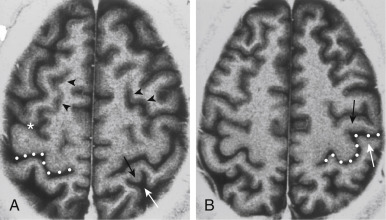
The central sulcus enters the paracentral lobule anterior to the marginal ramus of the cingulate sulcus.
The medial end of the post central sulcus is shaped like a bifid “y” and the bifid ends enclose the marginal ramus of the cingulate sulcus.
The superior frontal sulcus terminates in the precentral sulcus and the central sulcus is the next sulcus posterior to the precentral sulcus.
The interparietal sulcus intersects the postcentral sulcus.
The knob representing the hand motor area is in the precentral gyrus.
The precentral gyrus’ cortical gray matter thickness is greater than that of the postcentral gyrus thickness. Usually PRE/POST thickness ratio is about 1.5/1.
The peri-Rolandic cortex is more hypointense than surrounding cortex on FLAIR.
See Fig. 1-14 .
From the motor cortex of the frontal lobe, the white matter fibers pass into the corticospinal tract, which extends through the white matter of the centrum semiovale to the posterior limb of the internal capsule. From the posterior portion of the posterior limb of the internal capsule, the corticospinal tract continues through the central portion of the cerebral peduncle in the anterior portion of the midbrain. These fibers continue in the anterior portion of the pons to the pyramids of the medulla, where most of them decussate (in the pyramidal decussation) and proceed inferiorly in the lateral corticospinal tract of the spinal cord. Fifteen percent of fibers do not decussate in the medulla. These fibers pass into the anterior funiculus along the anterior median fissure of the spinal cord as the anterior corticospinal tract. The fibers of the pyramidal tract, which include both the lateral and anterior corticospinal tract, synapse with the anterior horn cell spinal cord nuclei.
Motor supply to the face travels from the cortex, through the corona radiata, into the genu of the internal capsule, via the corticobulbar tract. The corticobulbar fibers are located more anteromedially in the cerebral peduncles and have connections to the brain stem nuclei as they descend. Most of the connections to the various cranial nerve nuclei are contralateral to the cortical bulbar tract; however, some ipsilateral fibers are present as well.
The pyramidal tract is responsible for voluntary movement and contains the corticospinal and corticobulbar fibers. The extrapyramidal system includes the corpus striatum, which receives fibers from the cerebral cortex, the thalamus, and the substantia nigra, with connections to the caudate nucleus and putamen. These fibers originate from the cerebral cortex but pass through the internal and external capsule to reach the basal ganglia. The dentate nuclei, found in the cerebellar hemispheres, also send tracts to the thalamus and motor areas of the frontal cortex. The red nucleus of the midbrain receives fibers from the cortical motor area and transmits fibers via the rubrospinal tract to the spinal cord, which also regulates motion.
Abnormalities of the pyramidal system mainly produce weakness, paralysis, or spasticity of voluntary motor function. Extrapyramidal system abnormalities often produce involuntary movement disorders including tremors, choreiform (jerking) movements, athetoid (slow sinuous) movements, hemiballismic (flailing) motions, and muscular rigidity (think: pyramid, paralysis; extrapyramidal, extremity excesses).
Supposedly, humans get the greatest degree of satisfaction from their sense of touch. Certainly, a good back scratch can satiate many a need, but the sense of touch goes beyond merely a light touch on the back. It also includes pain (an inadvertent scratch by the nails), vibration (add a pulsating massager), and position sense (lying on one’s stomach).
The sensory system of the CNS is separated into fibers that transmit the sensations of pain and temperature, position, vibration, and general fine touch ( Fig. 1-17, A; Table 1-3 ). From the body, pain and temperature primary neuron fibers are transmitted by peripheral nerve fibers. The pain and temperature sensations are transmitted to the dorsal root ganglia of the spinal cord, where fibers may ascend or descend for one or two spinal segments before terminating in the region of the substantia gelatinosa of the dorsal horn. From the secondary neurons of the nucleus proprius of the dorsal horn, the fibers cross the midline in the anterior white commissures of the spinal cord and ascend in the lateral spinothalamic tract. The lateral spinothalamic tract is identified in the lateral midportion of the medulla and centrally in the pons where it is renamed the spinal lemniscus. The spinal lemniscus proceeds through the anterolateral portion of the dorsal pons and along the lateral aspect of the midbrain. From there the fibers synapse with tertiary neurons in the ventral posterolateral thalamic nucleus and then terminate in the somesthetic area of the parietal lobe in the postcentral sulcus region.
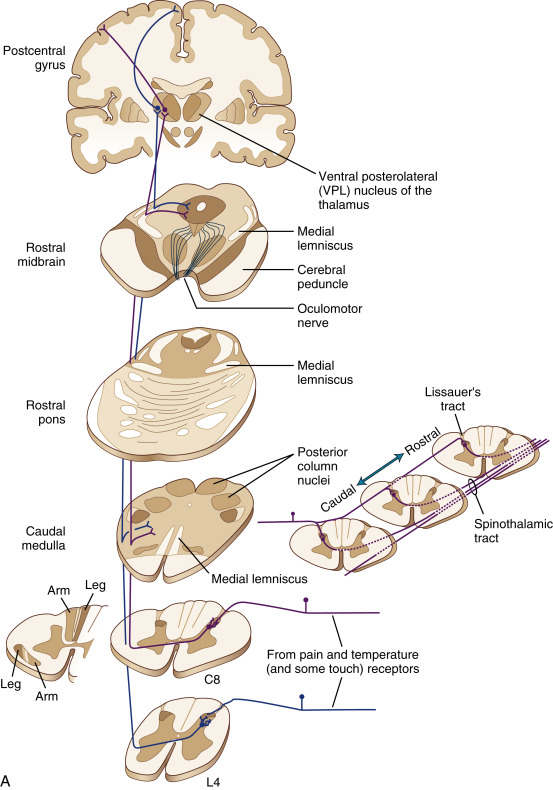
| Tract | Course | Function |
|---|---|---|
| Medial lemniscus | From posterior white matter of cord to dorsal nuclei of medulla, through decussation, to medial lemniscus to thalamus to anterior limb of internal capsule to primary sensory cortex | Touch and limb position sense |
| Spinothalamic tract | Dorsal horn of cord to spinal decussation to anterolateral spinal tract to reticular formation of pons, medulla, thalamus | Pain and temperature |
| Lateral lemniscus | From auditory fibers in caudal pons, crossed and uncrossed, to inferior colliculus, to medial geniculate of thalamus to primary auditory cortex | Auditory |
Pain and temperature sensation from the face is transmitted via the primary neuron axons of cranial nerve V, with the nuclei identified in the trigeminal ganglion. The axons from the trigeminal ganglion descend in the spinal trigeminal tract. The fibers terminate in the secondary neuron nucleus of the trigeminal spinal tract, which extends from the lower medulla to the C3 level of the spinal cord. At this point the pain and temperature fibers cross the midline to the contralateral side and ascend as the trigeminothalamic tract, which passes medial to the lateral spinothalamic tract but terminates also in the ventral posterior (lateral) thalamic nucleus. From there tertiary neuron fibers pass to the somesthetic area of the cerebral cortex.
Light touch and pressure from the body are transmitted in the ipsilateral posterior column of the spinal cord and contralateral anterior column (see Fig. 1-17, B ). The ascending branches may travel up to six to eight segments of the spinal cord before crossing to the contralateral side. Once again, a synapse is present in the nucleus proprius of the dorsal horn. From there, the white matter tracts form the anterior spinothalamic tracts, included as part of the spinal lemniscus. These axons also terminate in the ventral posterior (lateral) thalamic nucleus passing through the anterior portion of the internal capsule and the centrum semiovale to the somesthetic cortex. The spinal lemniscus lies lateral to the medial lemniscus in the posterior pons.
The pathway for light touch of the face is identical to that of the pain and temperature. However, termination of these cranial nerve V fibers occurs in a more superior portion of the nucleus of the trigeminal spinal tract. In addition, these fibers may bifurcate on entering the pons and synapse with the chief sensory nucleus of V within the pons.
The body’s sense of proprioception, fine touch, and vibration is transmitted via proprioceptors, which bifurcate in the posterior columns of the spinal cord. A portion of the fibers descend and make up the afferent loop of fiber reflex arcs; however, the ascending portion passes superiorly in the fasciculus gracilis and the fasciculus cuneatus, which terminate in their respective nuclei in the medulla. These fibers ascend ipsilaterally only. From the nucleus gracilis and nucleus cuneatus the axons cross the midline of the medulla and continue superiorly as the medial lemniscus found in the posterior portion of the medulla and pons before terminating in the ventral posterolateral (VPL) nucleus of the thalamus. From the VPL, the path is through the internal capsule to get to the primary somatosensory cortex.
Fine tactile fibers from the face terminate in the chief sensory nucleus or the mesencephalic nucleus of cranial nerve V. The fibers going to the chief sensory nucleus of cranial nerve V then cross the midline and ascend as the trigeminothalamic tract (ventral trigeminal lemniscus), whereas the fibers going to the mesencephalic nucleus of nerve V ascend ipsilaterally in the dorsal trigeminal lemniscus. From the mesencephalic nucleus in the midbrain, however, these fibers cross the midline at the red nucleus level and ascend to the ventral posteromedial thalamic nucleus. The pathways from both the body and face terminate in the somesthetic area of the cerebral cortex after passing through the posterior limb of the internal capsule.
The image received by the rods and cones of the retina is passed to secondary sensory ganglion cells of the retina and is then transmitted along the second cranial nerve—the optic nerve. The optic nerve ascends obliquely through the optic canal to join fibers from the contralateral optic nerve at the optic chiasm ( Fig. 1-18 ). The temporal retina fibers (nasal field) remain uncrossed and pass to the ipsilateral optic tract. The fibers from the nasal retina (temporal fields) decussate to join the nondecussating nasal field fibers from the opposite optic nerve continuing in the postchiasmal optic tract. However, before they cross, some of the inferonasal retinal fibers loop for a short distance up into the contralateral optic nerve in what is termed Wilbrand knee. This accounts for the signs of the “junctional syndrome” found in a lesion that compresses one optic nerve and the looping contralateral Wilbrand fibers. This results in a central scotoma in the ipsilateral eye and a superotemporal visual defect in the contralateral eye. Ninety percent of the fibers in the chiasm are from the macula of the retina; the crossing fibers lie superiorly and posteriorly in the chiasm. The optic tract encircles the anterior portion of the midbrain before terminating in the lateral geniculate body of the thalamus.
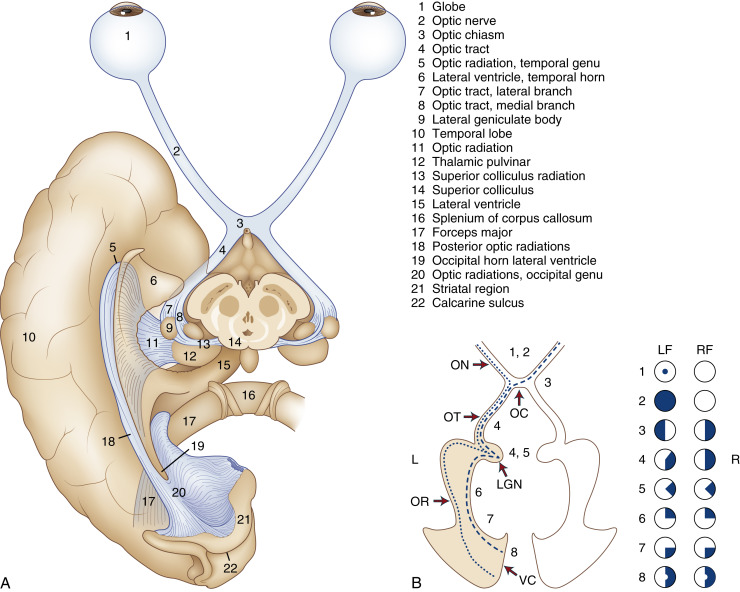
The lateral geniculate body is located in the posterolateral portion of the thalamus within the pulvinar nucleus. A few fibers ascend to the Edinger-Westphal nucleus (cranial nerve III) in the pretectal portion of the midbrain as part of the pupillary reflex, and some connect to the superior colliculus for tracking ability. From the lateral geniculate nucleus, tertiary neuronal fibers pass in the geniculocalcarine tract (optic radiations), course through portions of the posterior limb of the internal capsule and around the lateral ventricle, and terminate in the visual calcarine cortex in the medial occipital lobe. The superior optic radiations (inferior visual fields) pass through the parietal lobe on their way to the superior visual cortex of the occipital lobe. The inferior optic radiations (superior visual fields) are called Meyers loop fibers. They pass over the anteroinferior aspect of the lateral ventricle (around the temporal horn) into the temporal lobe to terminate in the inferior visual cortex just below the calcarine sulcus. An optic radiation lesion is localized depending on whether there are signs of neglect or sensory loss (superior radiation–parietal lobe lesion) or dysphasia and memory loss (Meyers loop- temporal lobe lesion).
Thus, lesions in the optic nerve cause blindness of the ipsilateral eye. Lesions in the midline at the level of the optic chiasm will cause bitemporal defects. Lesions compressing the lateral edge of the optic chiasm cause a nasal hemianopsia of the ipsilateral eye. Lesions of the optic tract extending to the lateral geniculate, and primary lesions of the lateral geniculate nucleus cause a contralateral homonymous hemianopsia. Lesions of the geniculocalcarine tract or visual cortex cause a contralateral homonymous hemianopsia (see Fig. 1-18, B ). The optic nerve is unique amongst the cranial nerves in that it is consists of an extension of the CNS white matter surrounded by dural sheath, and is therefore not a peripheral nerve like the other cranial nerves. The optic nerve is subject to the pathologies instrinsic to white matter in the brain (such as multiple sclerosis) and its sheath subject to dural based processes.
Sparing of macular vision with cortical strokes is common, and one of four explanations is possible: (1) localization of macular fibers to the watershed area of middle and posterior cerebral artery supply, allowing for dual vascular supply to be present; (2) a very large cortical area devoted to central vision, meaning that small strokes will not affect all fibers; (3) some decussation of macular fibers, so that they are bilaterally represented; and (4) testing artifact because of poor central fixation by the subject.
Become a Clinical Tree membership for Full access and enjoy Unlimited articles
If you are a member. Log in here